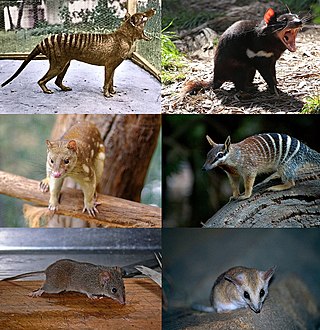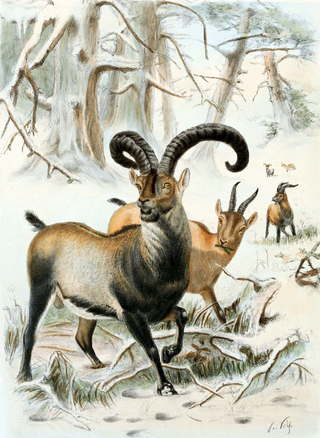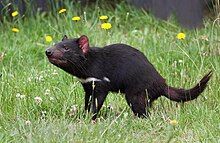
Diprotodon is an extinct genus of marsupial from the Pleistocene of Australia containing one species, D. optatum. The earliest finds date to 1.77 million to 780,000 years ago but most specimens are dated to after 110,000 years ago. Its remains were first unearthed in 1830 in Wellington Caves, New South Wales, and contemporaneous paleontologists guessed they belonged to rhinos, elephants, hippos or dugongs. Diprotodon was formally described by English naturalist Richard Owen in 1838, and was the first named Australian fossil mammal, and led Owen to become the foremost authority of his time on other marsupials and Australian megafauna, which were enigmatic to European science.

The thylacine, also commonly known as the Tasmanian tiger or Tasmanian wolf, is an extinct carnivorous marsupial that was native to the Australian mainland and the islands of Tasmania and New Guinea. The thylacine died out on New Guinea and mainland Australia around 3,600-3,200 years ago, prior to the arrival of Europeans, possibly because of the introduction of the dingo, whose earliest record dates to around the same time, but which never reached Tasmania. Prior to European settlement, around 5,000 remained in the wild on Tasmania. Beginning in the nineteenth century, they were perceived as a threat to the livestock of farmers and bounty hunting was introduced. The last known of its species died in 1936 at Hobart Zoo in Tasmania. The thylacine is widespread in popular culture and is a cultural icon in Australia.

The Tasmanian devil is a carnivorous marsupial of the family Dasyuridae. It was formerly present across mainland Australia, but became extinct there around 3,500 years ago. The size of a small dog, the Tasmanian devil became the largest carnivorous marsupial in the world following the extinction of the thylacine in 1936. It is related to quolls, and distantly related to the thylacine. It is characterised by its stocky and muscular build, black fur, pungent odour, extremely loud and disturbing screech, keen sense of smell, and ferocity when feeding. The Tasmanian devil's large head and neck allow it to generate among the strongest bites per unit body mass of any extant predatory land mammal. It hunts prey and scavenges on carrion.

Dasyuromorphia is an order comprising most of the Australian carnivorous marsupials, including quolls, dunnarts, the numbat, the Tasmanian devil, and the extinct thylacine. In Australia, the exceptions include the omnivorous bandicoots and the marsupial moles. Numerous South American species of marsupials are also carnivorous, as were some extinct members of the order Diprotodontia, including extinct kangaroos and thylacoleonids, and some members of the partially extinct clade Metatheria and all members of the extinct superorder Sparassodonta.

Thylacinidae is an extinct family of carnivorous, superficially dog-like marsupials from the order Dasyuromorphia. The only species to survive into modern times was the thylacine, which became extinct in 1936.

Genyornis newtoni, also known as the newton's mihirung, newton's thunder bird or mihirung paringmal, is an extinct species of large, flightless bird that lived in Australia during the Pleistocene Epoch until around 50,000 years ago. Over two metres in height, they were likely herbivorous. Many other species of Australian megafauna became extinct in Australia around that time, coinciding with the arrival of humans. It is the last known member of the extinct flightless bird family Dromornithidae which had been part of the fauna of the Australian continent for over 30 million years. They are not closely related to ratites such as emus, and their closest living relatives are thought to be fowl.

Thylacinus is a genus of extinct carnivorous marsupials from the order Dasyuromorphia. The only recent member was the thylacine, commonly also known as the Tasmanian tiger or Tasmanian wolf. The last known Tasmanian tiger was in the Beaumaris Zoo in Tasmania, eventually passing away in 1936. Alleged sightings of the tiger were reported after its extinction, however, no photographs or physical proof have been found to support the claims. In the first half of the 20th century, an already dwindling thylacine population was exposed to a combination of excessive hunting by humans, as well as likely competition with introduced dogs. Other prehistoric species are known from this genus. An unidentified species is known from Pleistocene New Guinea. Thylacines emerged around four million years ago and were known to inhabit Australia before they disappeared, most likely due to competition with dingos. Their last known stronghold was in Tasmania before they became extinct due to European hunting.

Thylacoleo is an extinct genus of carnivorous marsupials that lived in Australia from the late Pliocene to the late Pleistocene. Some of these marsupial lions were the largest mammalian predators in Australia of their time, with Thylacoleo carnifex approaching the weight of a lioness. The estimated average weight for the species ranges from 101 to 130 kg.

The term Australian megafauna refers to the megafauna in Australia during the Pleistocene Epoch. Most of these species became extinct during the latter half of the Pleistocene, and the roles of human and climatic factors in their extinction are contested.

Dromornithidae, known as mihirungs and informally as thunder birds or demon ducks, were a clade of large, flightless Australian birds of the Oligocene through Pleistocene Epochs. All are now extinct. They were long classified in Struthioniformes, but are now usually classified as galloanseres. Dromornithids were part of the Australian megafauna. One species, Dromornis stirtoni, was 3 m tall. Only a single species, Genyornis newtoni survived into the Late Pleistocene. They are thought to have been herbivorous.
Australian archaeology is a large sub-field in the discipline of archaeology. Archaeology in Australia takes four main forms: Aboriginal archaeology, historical archaeology, maritime archaeology and the archaeology of the contemporary past. Bridging these sub-disciplines is the important concept of cultural heritage management, which encompasses Aboriginal and Torres Strait Islander sites, historical sites, and maritime sites.
In Australian folklore, the Queensland tiger is a creature said to live in the Queensland area in eastern Australia.
The mammals of Australia have a rich fossil history, as well as a variety of extant mammalian species, dominated by the marsupials, but also including monotremes and placentals. The marsupials evolved to fill specific ecological niches, and in many cases they are physically similar to the placental mammals in Eurasia and North America that occupy similar niches, a phenomenon known as convergent evolution. For example, the top mammalian predators in Australia, the Tasmanian tiger and the marsupial lion, bore a striking resemblance to large canids such as the gray wolf and large cats respectively; gliding possums and flying squirrels have similar adaptations enabling their arboreal lifestyle; and the numbat and anteaters are both digging insectivores. Most of Australia's mammals are herbivores or omnivores.

Palorchestes is an extinct genus of large terrestrial, herbivorous Australian marsupial of the family Palorchestidae, living from the Miocene through to the Late Pleistocene. Like other palorchestids, it had highly retracted nasal region suggesting that it had a prehensile lip, as well as highly unusual clawed forelimbs that were used to grasp vegetation.

The Tasmanian emu is an extinct subspecies of emu. It was found in Tasmania, where it had become isolated during the Late Pleistocene. As opposed to the other insular emu taxa, the King Island emu and the Kangaroo Island emu, the population on Tasmania was sizable, meaning that there were no marked effects of small population size as in the other two isolates.
Devil's Lair is a single-chamber cave with a floor area of around 200 m2 (2,200 sq ft) that formed in a Quaternary dune limestone of the Leeuwin–Naturaliste Ridge, 5 km (3.1 mi) from the modern coastline of Western Australia. The stratigraphic sequence in the cave floor deposit consists of 660 cm (260 in) of sandy sediments, with more than 100 distinct layers, intercalated with flowstone and other indurated deposits. Excavations have been made in several areas of the cave floor. Since 1973, excavations have been concentrated in the middle of the cave, where 10 trenches have been dug. Archaeological evidence for intermittent human occupation extends down about 350 cm (140 in) to layer 30, with hearths, bone, and stone artefacts found throughout. The site provides evidence of human habitation of Southwest Australia 50,000 years before the present day.

Simosthenurus, also referred to as the short-faced kangaroo, is an extinct genus of megafaunal macropods that existed in Australia, specifically Tasmania, during the Pleistocene. Analysis of Simosthenurus fossils has contributed to the finding that there are three lineages of macropods: Sthenurinae, Macropodinae, and Lagostrophinae. The genus Simosthenurus was among the sthenurines.

Megalibgwilia is a genus of echidna known only from Australian fossils that incorporates the oldest-known echidna species. The genus ranged from the Miocene until the late Pleistocene, becoming extinct about 50,000 years ago. Megalibgwilia species were more widespread in warmer and moist climates. The extinction can be attributed to increasing aridification in Southern Australia.

The biodiversity of Tasmania is of exceptional biological and paleoecological interest. A state of Australia, it is a large South Pacific archipelago of one large main island and a range of smaller islands. The terrain includes a variety of reefs, atolls, many small islands, and a variety of topographical and edaphic regions on the largest island, all of which promote the development of unusually concentrated biodiversity. During long periods geographically and genetically isolated, it is known for its unique flora and fauna. The region's climate is oceanic.

De-extinction is the process of generating an organism that either resembles or is an extinct species. There are several ways to carry out the process of de-extinction. Cloning is the most widely proposed method, although genome editing and selective breeding have also been considered. Similar techniques have been applied to certain endangered species, in hopes to boost their genetic diversity. The only method of the three that would provide an animal with the same genetic identity is cloning. There are benefits and drawbacks to the process of de-extinction ranging from technological advancements to ethical issues.














